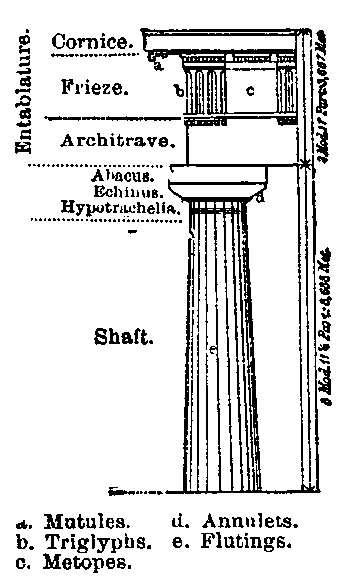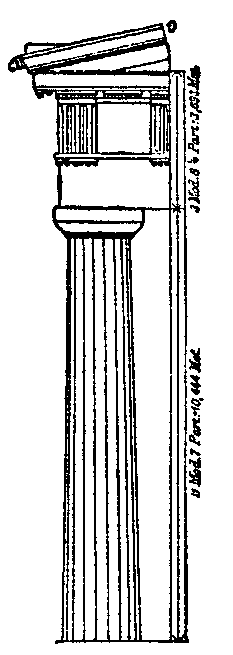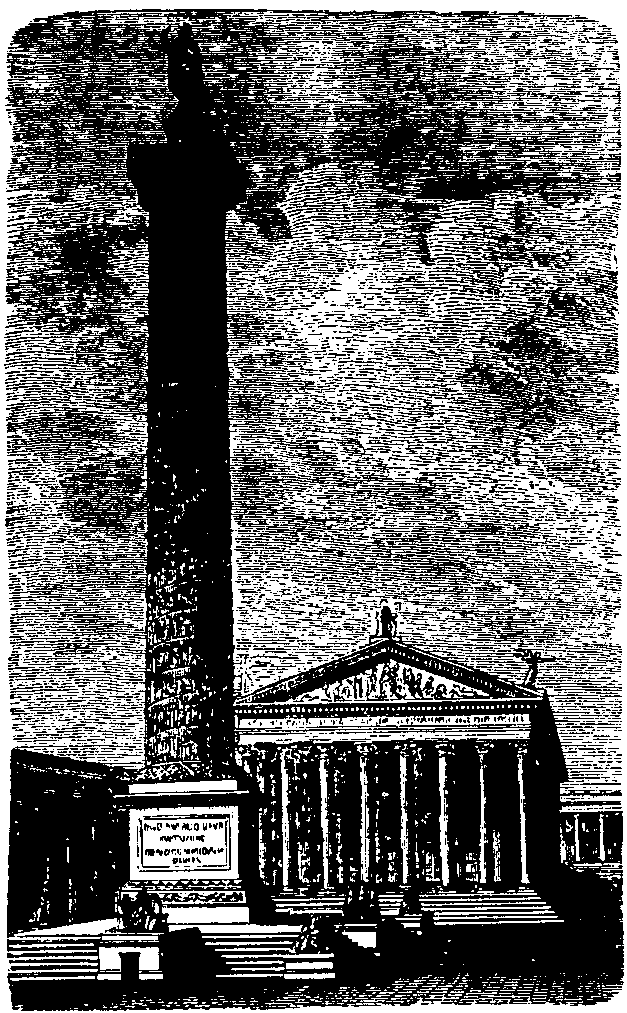|
Dictionary: Search the Dictionary Browse the Dictionary |
|
Timeline: Launch Interactive Timeline |
| Return to Front Page |
| ARCHITECTURE, ORDERS OF | |
Deprecated: Function split() is deprecated in /www/www-ccat/data/classics/myth/php/tools/dictionary.php on line 64 In Greek architecture there were three orders of columns: the Doric, Ionic, and Corinthian. (I) Doric: Figures 1 and 2 give instances of the Doric style from the temple at Paestum and the Parthenon at Athens. The Doric column consists (a) of the shaft, which increases in diameter almost invisibly up to about one-quarter of its height, and diminishes slightly after that point. It has no base, but rests immediately on the stylobate. It is surrounded with semi-circular flutings, meeting each other at a sharp angle. These were chiselled with a cedar-wood tool after the separate drums had been put together. (b) The capital (Lat. capitulum). This consists of three parts, (a) the hypotrachelion, or neck of the column, a continuation of the shaft, but separated by an indentation from the other drums. It is wider at the top than at the bottom, and is generally ornamented with several parallel and horizontal rings. (b) The echinus, a circular moulding or cushion, which widens greatly towards the top. (c) The abax or abacus, a square slab supporting the architrave or episylion. The height of the shaft is usually 5 1/2 times, the distance between the columns 1 1/2 times the diameter of the base of the column. The architrave is a quadrangular beam of stone, reaching from pillar to pillar. On this again rests the frieze, zophoros, so called from the metopes which are adorned with sculptures in relief. These metopes are square spaces between the triglyphs: the triglyphs are surfaces out into three concave grooves, two whole grooves in the centre, and two half grooves at the sides. One is placed over each pillar, and one between each pair of pillars. The entablature is completed by a projecting cornice, a slab crowned with a simple heading-course, the lower surface of which is ornamented with sloping corbels (Gk. stagones, Lat. mutuli). (II) Ionic Columns. An instance is given in fig. 3 from the temple on the Ilissus at Athens. These are loftier than the Doric, their height being 8 1/2-9 1/2 times the diameter of the, lower part. The enlargement of the lower part is also less than in the Doric columns, the distance between each column greater (two diameters), the flutings (generally 24 in number) deeper, and separated by small flat surfaces. The Ionic column has a base consisting of a square slab (plinthos), and several cushion like supports separated by grooves. The capital, again, is more artistically developed. The neck, instead of fluting, has five leaves worked in relief. The echinus is very small and ornamented with an egg pattern. Over it, instead of the abacus, is a Four-cornered cushion ending before and behind in spiral volutes, supporting a narrow square slab, which is also adorned with an egg pattern. The architrave is divided into three bands, projecting one above the other, and upon it rises, in an uninterrupted surface, the frieze, adorned with reliefs, continuously along its whole length. Finally, the cornice is composed of different parts. (III) The Corinthian column (fig. 4, from the monument of Lysicrates, at Athens). The base and shaft are identical with the Ionic, but the capital takes the form of an open calix formed of acanthus leaves. Above this is another set of leaves, from between which grow stalks with small leaves, rounded into the form of volutes. On this rests a small abacus widening towards the top, and on this again the entablature, which is borrowed from the Ionic order. On the human figures employed instead of columns to support the entablature, see ATLAS, CANEPHORI, CARYATIDES. The Romans adopted the Greek styles of column, but not always in their pure form. They were fondest of the Corinthian, which they laboured to enrich with new and often excessive ornamentation. For instance, they crowned the Corinthian capital with the Ionic, thus forming what is called the Roman or composite capital. The style known as Tuscan is a degenerate form of the Doric. The Tuscan column has a smooth shaft, in height=7 diameters of the lower part, and tapering up to three-quarters of its lower dimensions. Its base consists of two parts, a circular plinth, and a cushion of equal height. The capital is formed of three parts of equal height. In other styles, too, the Romans sometimes adopted the smooth instead of the fluted shaft, as for instance in the Pantheon (fig. 5). Single columns were sometimes erected by the Greeks, and in imitation of them by the Romans, as memorials to distinguished persons. A good example is the Columna Rostrata, or column with its shaft adorned with the beaks of ships, in the Roman Forum. This was set up in commemoration of the naval victory of Duilius over the Carthaginians (261 B.C.). Among the columns which survive, the most magnificent is that of Trajan, erected in the Forum of Trajan 113 A.D. It rises on a quadrangular pediment to the height of 124 feet; its diameter below is about 10 feet, and a little less in the upper part. An interior spiral staircase of 185 steps leads to the summit. The shaft, formed of twenty-three drums of marble, is adorned with a series of reliefs, 3 feet 3 inches high and 200 feet long, in a series of twenty-two spirals. They represent scenes in Trajan's Dacian campaigns, and contain 2,500 human figures, with animals, engines, etc. On a cylindrical pedestal at the summit there once stood a gilded statue of the emperor, which, since the year 1587, has made way for a bronze figure of St. Peter. A similar column is that of Marcus Aurelius, 122 feet high, on the Piazza Colonna. Since 1589 the statue of St. Paul has been substituted for that of the emperor. The reliefs, in twenty spirals, represent events in the emperor's war with the Marcomanni. |
|
|
|
|
| Pictures and Media | |
| From the Temple of Poseidon, Paestum. DORIC ORDER. |

|
| From the Parthernon, Athens. DORIC ORDER. a. Mutules b. Trigiyphs c. Metopes d. Annulets e. Flutings |

|
| From the Temple on the Ilissus, Athens. IONIC ORDER. |

|
| From the Monument of Lysicrates, Athens. CORINTHIAN ORDER. |

|
| From the Pantheon, Rome. CORINTHIAN ORDER. a. Cyma recta b. Corona c. Modillions. d. Ovolo. e. Cymation. f. Abacus g. Volutes. h. Astugal. i. Torus. k. Trochilus. l. Quadra. m. Pliata. |

|
| COLUMN OF MARCUS AURELIUS. (With its surroundings as restored by Carina, Arch. Rom. tav. 204.) |

|
|
Copyright 2000-2020 Peter T. Struck. No portion of this site may be copied or reproduced, electronically or otherwise, without the expressed, written consent of the author. |